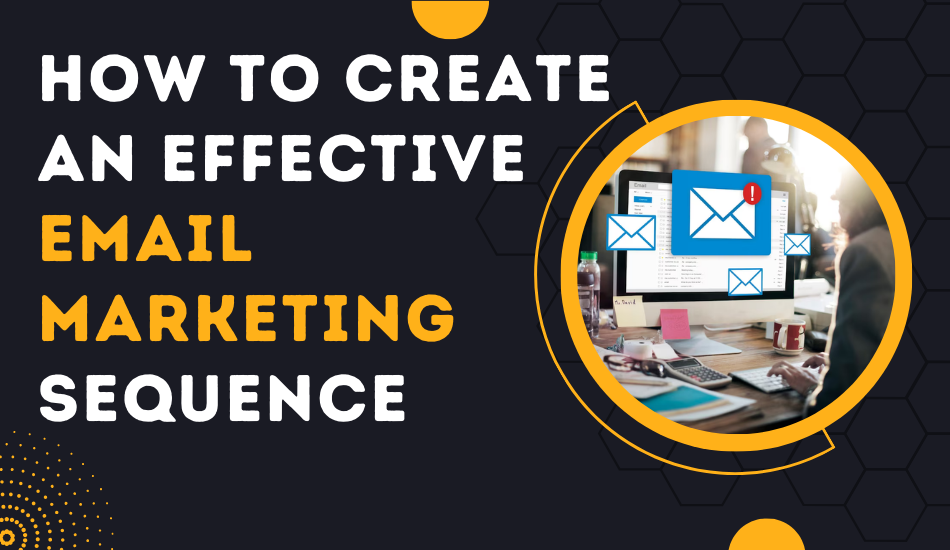How To Create An Effective Email Marketing Sequence
An email marketing sequence is a series of emails delivered to a subset of your email list’s subscribers. And an effective mail marketing sequence is extremely profitable because it’s proven that email marketing ROI can be as high as 3800%.
So what makes an effective email marketing sequence?
A series of emails are sent from software, based on desired parameters, with the purpose of converting prospects into customers. And these email marketing sequences are either trigger-based or time-based. Usually, marketers pursue specified goals for creating effective email marketing sequences.
So, it’s well worth the time and effort to devote to an effective email sequence. And these post is aimed to help you create a successful email sequence so that you can accomplish your desired ROI.
Let’s take a look.
1. Specific Objectives In The Email Marketing Sequence
To begin, you must understand your aim, and in order to do so, you must understand, and connect with your audience. This necessitates an understanding of the pain points they face.
Second, what is the goal of sending and producing the email marketing sequence in the first place? The idea is that you don’t just construct an email sequence because you think it’s the most effective marketing tactic.
It actually helps more if you have a clear aim in mind and are familiar with the email process.
2. Importance Of Subject Lines In Email Sequence
To increase your open rate, pay attention to your subject lines.
According to Optionmonster.com 47% of people open the emails based on the subject line and 69% of customers can report emails as spam based on the subject line only.
This metric helps in monitoring how well your content and emails are received by your subscribers.

If your open rate isn’t as high as you’d want, it’s probably because of your subject lines. Make sure they’re timely, concise, and to the point.
Make your most significant keywords the first few words in your email subject line.
And while they should be brief, you don’t want them to be dull or overburdened with content, since this would make them appear spammy.
3. Why CTA in Email Marketing Sequence?
Every goal you set should have its own call to action (CTA) that will assist you in achieving it. However, ensure that it is simple to understand, accurate, and clear to your reader.
The call to action (CTA) is an important part of an email because it serves as a guide for the user on what to do next. The CTA carries action words like “subscribe”, “download”, “buy here” etc.
Without a clear CTA, the user may be unsure of how to purchase a product or subscribe to a newsletter. As a result, customers are more likely to close the email without performing their expected action.
4. Specific Information In Effective Email Marketing Sequences
Keep each email to the topic and don’t go on for too long. Use your email to educate and deliver value to the client. To acquire their trust and loyalty, you must first surpass their expectations.

The more instructive content you offer with factual data that benefits your subscribers, the more likely they are to trust your expertise and develop trust with you.
5. Create Evergreen Email Marketing Content.
The best method of having a long-lasting customer base is to generate evergreen content.
Otherwise, you may be compelled to frequently modify your email marketing sequence.
And how do you avoid that? Well, just rule out too much trendy content that will turn obsolete in a few months. Instead, create content that will be useful for years to come.
6. Types of email marketing Sequences
1. Welcome Email For An Effective Sequence
Welcome emails offer your new subscribers a warm reception and usually provide them with suitable content at the right time when they are psychologically ready to receive it.

Ideally, you should send a welcome email to your new customer as soon as possible. Or else, you risk losing the customer’s interest if you wait.
If you’re a blogger, you can offer links to your favorite or most relevant blog posts that you think people should read.
After a new customer purchases a product or, more commonly, signs up for a service, onboarding emails are sent. These are not welcome emails.
Instead, these are emails that immediately demonstrate to a customer that the brand values their patronage.
Eventually, users want to see your email when they are ready mentally. It also entails gaining new clients while maintaining good relationships with existing ones.
2. Abandon Cart Email Sequence
In the world of eCommerce, an abandoned cart email is a must-have.
According to research, 44.1% of abandoned cart emails are opened, and almost a third of abandoned cart email clicks (29.9%) result in a recovered sale.
It’s a follow-up email sent to someone who has placed items in their shopping cart, gone through part of the checkout process, and then left the site without purchasing anything.
Hence these emails are effectively designed to entice clients back to the site and encourage them to complete the transaction they were about to make.
Time-based emails are sent at predefined intervals in a specific sequence. Such email sequences are also referred to as ‘autoresponders’.
Time-based email sequences essentially activate after a specific number of days. That could be after a purchase, the subscriber’s anniversary, or any other event that occurs over a period of time.
Another example of a time-based sequence is sending a thank you or welcome email immediately after an opt-in or transaction.
A trigger email campaign is a sequence of emails that are sent to recipients automatically in response to certain activities they take.
Signing up for a newsletter, adding products to the basket, and making a transaction are all examples of activities.
Customer- browsing behaviors, payment methods, content downloading are a few aspects that could trigger such emails.
3. Cold Subscriber Email Sequence
Cold email sequences are essentially those which go to people who have never heard of you before.
Alternatively, they may be interested in what you’re selling but aren’t ready to buy just yet.
A cold email sequence is designed to provide prospects with step-by-step information about a product or service they were previously unaware of.
Convertkit.com defines cold email subscribers as anyone who hasn’t opened or clicked an email in the last 90 days and has been on your email list for at least 30 days.
Related Posts
Top 5 Email Marketing Performance Indicators to Monitor
6 Reasons To Start Using Email Marketing For Massive Success
Conclusion
One of the most powerful and cost-effective ways to sell a product or service online is through effective email marketing.
And effective email sequences are crucial for increasing your return on investment (ROI).
Most importantly, they enable you to communicate directly with clients and customers, develop a relationship with them, and motivate them to take action.
So one of the most effective actions is to stick to the subject with focus and not go off on tangents. Instead, use your email to educate and provide value to your customer.
That’s why it’s crucial to decide the objective of your email initially.
Also, remember to tell your prospect what to do. Because that’s the only way to get them to take action. So, you must have a strong CTA.
And, often, innocuous-looking aspects like a subject line and a clear message play a vital role in the success of your email marketing sequence.
So let me hear from you about your plans of creating an effective email marketing sequence.


2 thoughts on “How To Create An Effective Email Marketing Sequence”
Good stuff. Most required for digital marketers
Hi Joseph,
Good to hear from you.
Yes this article can be helpful, and it actually helps more if we
have a clear aim in mind and are familiar with the email process.
Thanks for your comment.
Have a great time.